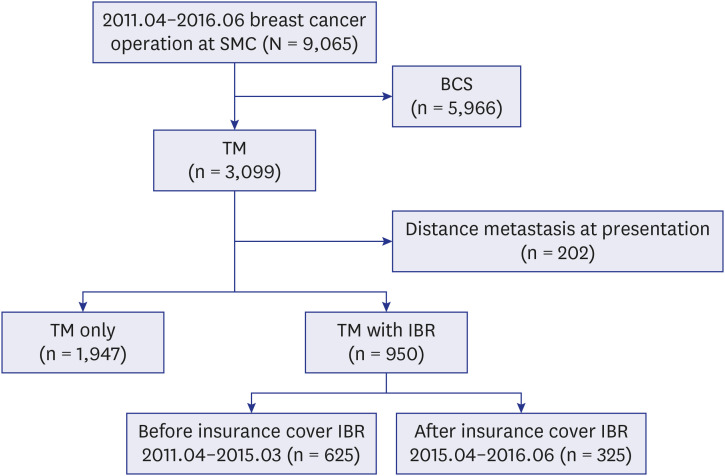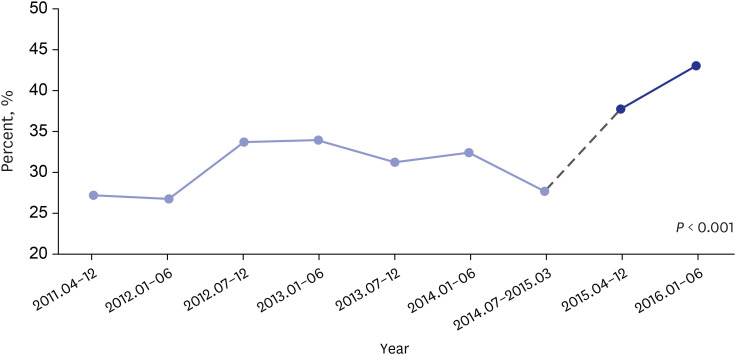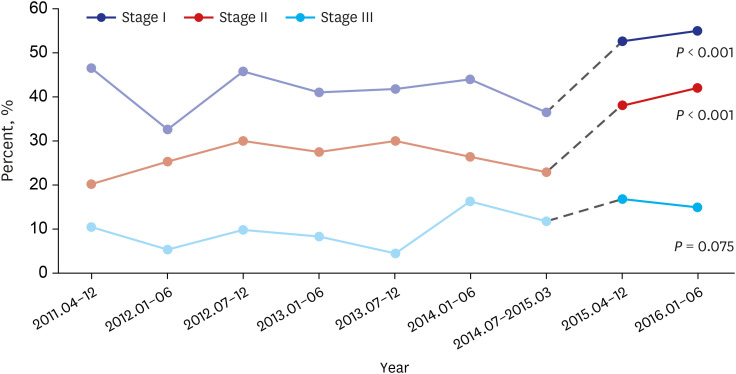J Korean Med Sci.
2021 Jul;36(29):e194. 10.3346/jkms.2021.36.e194.
Changes in Korean National Healthcare Insurance Policy and Breast Cancer Surgery Trend in Korea
- Affiliations
-
- 1Division of Breast and Endocrine Surgery, Department of Surgery, Samsung Medical Center, Sungkyunkwan University School of Medicine, Seoul, Korea
- 2Department of Surgery, College of Medicine, Majmaah University, Ministry of Education, Riyadh, Saudi Arabia
- 3Department of Plastic Surgery, Samsung Medical Center, Sungkyunkwan University School of Medicine, Seoul, Korea
- KMID: 2518740
- DOI: http://doi.org/10.3346/jkms.2021.36.e194
Abstract
- Background
Since April 2015, the Korean National Health Insurance (NHI) has reimbursed breast cancer patients, approximately 50% of the cost of the breast reconstruction (BR) procedure. We aimed to investigate NHI reimbursement policy influence on the rate of immediate BR (IBR) following total mastectomy (TM).
Methods
We retrospectively analyzed breast cancer data between April 2011 and June 2016. We divided patients who underwent IBR following TM for primary breast cancer into “uninsured” and “insured” groups using their NHI statuses at the time of surgery. Univariate analyses determined the insurance influence on the decision to undergo IBR.
Results
Of 2,897 breast cancer patients, fewer uninsured patients (n = 625) underwent IBR compared with those insured (n = 325) (30.0% vs. 39.8%, P < 0.001). Uninsured patients were younger than those insured (median age [range], 43 [38–48] vs. 45 [40–50] years; P < 0.001). Pathologic breast cancer stage did not differ between the groups (P = 0.383). More insured patients underwent neoadjuvant chemotherapy (P = 0.011), adjuvant radiotherapy (P < 0.001), and IBR with tissue expander insertion (P = 0.005) compared with those uninsured.
Conclusion
IBR rate in patients undergoing TM increased after NHI reimbursement.
Figure
Reference
-
1. Bray F, Ferlay J, Soerjomataram I, Siegel RL, Torre LA, Jemal A. Global cancer statistics 2018: GLOBOCAN estimates of incidence and mortality worldwide for 36 cancers in 185 countries. CA Cancer J Clin. 2018; 68(6):394–424. PMID: 30207593.
Article2. Hong S, Won YJ, Park YR, Jung KW, Kong HJ, Lee ES, et al. Cancer statistics in Korea: incidence, mortality, survival, and prevalence in 2017. Cancer Res Treat. 2020; 52(2):335–350. PMID: 32178489.
Article3. Min SY, Kim Z, Hur MH, Yoon CS, Park EH, Jung KW, et al. The basic facts of Korean breast cancer in 2013: results of a nationwide survey and breast cancer registry database. J Breast Cancer. 2016; 19(1):1–7. PMID: 27066090.
Article4. Jung KW, Won YJ, Kong HJ, Lee ES. Prediction of cancer incidence and mortality in Korea, 2019. Cancer Res Treat. 2019; 51(2):431–437. PMID: 30913864.
Article5. Stevens LA, McGrath MH, Druss RG, Kister SJ, Gump FE, Forde KA. The psychological impact of immediate breast reconstruction for women with early breast cancer. Plast Reconstr Surg. 1984; 73(4):619–628. PMID: 6709743.
Article6. Schain WS. Breast reconstruction. Update of psychosocial and pragmatic concerns. Cancer. 1991; 68(5):Suppl. 1170–1175. PMID: 1913501.
Article7. Liang TJ, Wang BW, Liu SI, Yeh MH, Chen YC, Chen JS, et al. Recurrence after skin-sparing mastectomy and immediate transverse rectus abdominis musculocutaneous flap reconstruction for invasive breast cancer. World J Surg Oncol. 2013; 11(1):194. PMID: 23945398.
Article8. Drucker-Zertuche M, Robles-Vidal C. A 7 year experience with immediate breast reconstruction after skin sparing mastectomy for cancer. Eur J Surg Oncol. 2007; 33(2):140–146. PMID: 17112698.
Article9. van Mierlo DR, Lopez Penha TR, Schipper RJ, Martens MH, Serroyen J, Lobbes MB, et al. No increase of local recurrence rate in breast cancer patients treated with skin-sparing mastectomy followed by immediate breast reconstruction. Breast. 2013; 22(6):1166–1170. PMID: 24025989.
Article10. Kim Z, Min SY, Yoon CS, Jung KW, Ko BS, Kang E, et al. The basic facts of Korean breast cancer in 2012: results from a nationwide survey and breast cancer registry database. J Breast Cancer. 2015; 18(2):103–111. PMID: 26155285.
Article11. Hershman DL, Richards CA, Kalinsky K, Wilde ET, Lu YS, Ascherman JA, et al. Influence of health insurance, hospital factors and physician volume on receipt of immediate post-mastectomy reconstruction in women with invasive and non-invasive breast cancer. Breast Cancer Res Treat. 2012; 136(2):535–545. PMID: 23053659.
Article12. McGuire KP, Santillan AA, Kaur P, Meade T, Parbhoo J, Mathias M, et al. Are mastectomies on the rise? A 13-year trend analysis of the selection of mastectomy versus breast conservation therapy in 5865 patients. Ann Surg Oncol. 2009; 16(10):2682–2690. PMID: 19653046.
Article13. Gomez SL, Lichtensztajn D, Kurian AW, Telli ML, Chang ET, Keegan TH, et al. Increasing mastectomy rates for early-stage breast cancer? Population-based trends from California. J Clin Oncol. 2010; 28(10):e155–e157. PMID: 20159812.
Article14. Reddy S, Colakoglu S, Curtis MS, Yueh JH, Ogunleye A, Tobias AM, et al. Breast cancer recurrence following postmastectomy reconstruction compared to mastectomy with no reconstruction. Ann Plast Surg. 2011; 66(5):466–471. PMID: 21451372.
Article15. Gerber B, Krause A, Dieterich M, Kundt G, Reimer T. The oncological safety of skin sparing mastectomy with conservation of the nipple-areola complex and autologous reconstruction: an extended follow-up study. Ann Surg. 2009; 249(3):461–468. PMID: 19247035.
Article16. Ota D, Fukuuchi A, Iwahira Y, Kato T, Takeuchi M, Okamoto J, et al. Clinical outcome of reconstruction with tissue expanders for patients with breast cancer and mastectomy. Clin Breast Cancer. 2014; 14(5):339–345. PMID: 24569103.
Article17. Park SH, Han W, Yoo TK, Lee HB, Jin US, Chang H, et al. Oncologic safety of immediate breast reconstruction for invasive breast cancer patients: a matched case control study. J Breast Cancer. 2016; 19(1):68–75. PMID: 27064557.
Article18. Patel RT, Webster DJ, Mansel RE, Hughes LE. Is immediate postmastectomy reconstruction safe in the long-term? Eur J Surg Oncol. 1993; 19(4):372–375. PMID: 8359285.19. Pinel-Giroux FM, El Khoury MM, Trop I, Bernier C, David J, Lalonde L. Breast reconstruction: review of surgical methods and spectrum of imaging findings. Radiographics. 2013; 33(2):435–453. PMID: 23479706.
Article20. Ryu JM, Park S, Paik HJ, Nam SJ, Kim SW, Lee SK, et al. Oncologic safety of immediate breast reconstruction in breast cancer patients who underwent neoadjuvant chemotherapy: short-term outcomes of a matched case-control study. Clin Breast Cancer. 2017; 17(3):204–210. PMID: 28065399.
Article21. Eltahir Y, Werners LL, Dreise MM, van Emmichoven IA, Jansen L, Werker PM, et al. Quality-of-life outcomes between mastectomy alone and breast reconstruction: comparison of patient-reported BREAST-Q and other health-related quality-of-life measures. Plast Reconstr Surg. 2013; 132(2):201e–209e.22. Zhong T, Hu J, Bagher S, Vo A, O'Neill AC, Butler K, et al. A Comparison of psychological response, body image, sexuality, and quality of life between immediate and delayed autologous tissue breast reconstruction: a prospective long-term outcome study. Plast Reconstr Surg. 2016; 138(4):772–780. PMID: 27673514.23. Al-Ghazal SK, Sully L, Fallowfield L, Blamey RW. The psychological impact of immediate rather than delayed breast reconstruction. Eur J Surg Oncol. 2000; 26(1):17–19. PMID: 10718173.
Article24. Metcalfe DB, Duggal CS, Gabriel A, Nahabedian MY, Carlson GW, Losken A. Prevalence of body dysmorphic disorder among patients seeking breast reconstruction. Aesthet Surg J. 2014; 34(5):733–737. PMID: 24809358.
Article25. Morrow M, Scott SK, Menck HR, Mustoe TA, Winchester DP. Factors influencing the use of breast reconstruction postmastectomy: a National Cancer Database study. J Am Coll Surg. 2001; 192(1):1–8. PMID: 11192909.
Article26. Reuben BC, Manwaring J, Neumayer LA. Recent trends and predictors in immediate breast reconstruction after mastectomy in the United States. Am J Surg. 2009; 198(2):237–243. PMID: 19306977.
Article27. Shaikh IA, Thomas H, Vidyadharan R, Verghis V, Iype V, Abraham SJ. Post mastectomy immediate breast reconstruction 13 years experience in a single centre. Indian J Surg Oncol. 2010; 1(3):250–255. PMID: 22693373.
Article28. Oda A, Kuwabara H, Fushimi K. Disparities associated with breast reconstruction in Japan. Plast Reconstr Surg. 2013; 132(6):1392–1399. PMID: 24281569.
Article
- Full Text Links
- Actions
-
Cited
- CITED
-
- Close
- Share
- Similar articles
-
- Priority analysis of the healthcare policy using analytic hierarchy process
- The Impact of Time-to-Treatment for Outcome in Cancer Patients, and Its Differences by Region and Time Trend
- Election Pledge and Policy Tasks of President Moon Jae-in in Healthcare Sector
- Establishment of Healthcare Delivery System through Improvement of Health Insurance System
- Health insurance policies for magnetic resonance imaging tests in Korea




